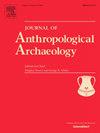Contrasting strategies: Social organization and interaction in the Early Bronze Age of northwestern Scandinavia
IF 2.2
1区 社会学
Q1 ANTHROPOLOGY
引用次数: 0
Abstract
The transition to the Nordic Bronze Age included new technological innovations, social institutions and sociopolitical structures pushed by extensive long-distance exchange of metals and other exotica. However, traditional views often oversimplify this as a simple two-way trade system, failing to adequately explain the complex interactions in and between the regions like Scandinavia in which the societies organised themselves based on varied strategies tied to local resource potentials. Recent research, involving methods such as isotopic analysis and genomic sequencing, has provided solid evidence of movement and interaction. Despite this progress, the evidence at hand often lacks well-founded interpretations grounded in thorough theoretical frameworks. This study addresses interpretive challenges by employing an innovative framework grounded in collective action theory, integrating other aspects of social complexity and supported by regional datasets to achieve a more nuanced understanding of social dynamics. This approach informs us about the complex and contrasting organizational strategies and trade networks across northwestern Scandinavia (i.e. modern-day Norway up to the borders of Troms), illustrating further how local societies contributed to broader European networks. The study aims to offer a nuanced understanding of the region’s social dynamics, highlighting the interplay between coercive and cooperative strategies within the overarching Nordic Bronze Age system.

对比策略:斯堪的纳维亚西北部青铜时代早期的社会组织与互动
向北欧青铜时代的过渡包括新的技术创新、社会制度和社会政治结构,这些都是由金属和其他外来物品的广泛远距离交换所推动的。然而,传统观点往往将其过度简化为简单的双向贸易体系,未能充分解释斯堪的纳维亚等地区内部和之间复杂的相互作用,在这些地区中,社会根据与当地资源潜力相关的各种策略组织起来。最近的研究,包括同位素分析和基因组测序等方法,已经提供了运动和相互作用的确凿证据。尽管取得了这些进展,但手头的证据往往缺乏基于彻底理论框架的有充分根据的解释。本研究采用以集体行动理论为基础的创新框架,整合社会复杂性的其他方面,并以区域数据集为支持,以实现对社会动态的更细致的理解,从而解决了解释方面的挑战。这种方法让我们了解了斯堪的纳维亚半岛西北部(即现代挪威到特罗姆斯边境)复杂而鲜明的组织战略和贸易网络,进一步说明了当地社会如何为更广泛的欧洲网络做出贡献。该研究旨在对该地区的社会动态提供细致的理解,强调北欧青铜时代总体体系中强制与合作战略之间的相互作用。
本文章由计算机程序翻译,如有差异,请以英文原文为准。
求助全文
约1分钟内获得全文
求助全文
来源期刊

Journal of Anthropological Archaeology
Multiple-
CiteScore
4.00
自引率
11.10%
发文量
64
期刊介绍:
An innovative, international publication, the Journal of Anthropological Archaeology is devoted to the development of theory and, in a broad sense, methodology for the systematic and rigorous understanding of the organization, operation, and evolution of human societies. The discipline served by the journal is characterized by its goals and approach, not by geographical or temporal bounds. The data utilized or treated range from the earliest archaeological evidence for the emergence of human culture to historically documented societies and the contemporary observations of the ethnographer, ethnoarchaeologist, sociologist, or geographer. These subjects appear in the journal as examples of cultural organization, operation, and evolution, not as specific historical phenomena.
 求助内容:
求助内容: 应助结果提醒方式:
应助结果提醒方式:


